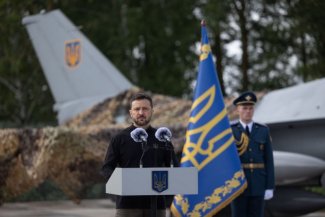The first F-16s have arrived in Ukraine. Day 894 of the war

![]()
Russian forces have completely pushed the Ukrainian troops out of the densely built-up area in Krasnohorivka and have also entered the administrative borders of Toretsk. In Krasnohorivka, the last town under Ukrainian control in the defensive belt facing the occupied city of Donetsk that was established in 2015, the defending forces are still holding out on the north-western outskirts. In the Toretsk agglomeration, the Russian forces have captured Zalizne, the centre of Pivnichne and the eastern part of Druzhba. Their advances in Zalizne have also forced the Ukrainian troops to withdraw from their fortified positions east of Niu-York as they were in danger of being encircled. Russian troops have also cut the main supporting road of Ukrainian forces south-west of Donetsk (between Marinka and Pavlivka) and thus started the battle for Kostiantynivka, which lies on this road, while flanking Vuhledar from the north-east. They have also continued their assault towards Pokrovsk, taking control of another three villages west of Vovcha. Thus, the Ukrainian attempt to establish a new defensive line along this river has failed. The main thrust of the Russian assault is the Avdiivka-Pokrovsk railway line; Russian forces are much closer to the latter town (about 15km away).
After breaking through the Ukrainian defences on the Donets-Donbas canal, Russian forces have entered the central part of Chasiv Yar, which lies west of it. They have succeeded in occupying the first precints in the Oktyabr microdistrict; Ukrainian counter-attacks aimed at pushing them back across the canal have failed. Russian troops have also made further advances in the areas of last year’s Ukrainian counter-offensive, driving the defending units out of their positions on the flanks of Robotyne and Urozhaine (south of Orikhiv and Velyka Novosilka respectively) and regaining control of Klishchiivka south-west of Bakhmut. Following a rotation of its fighting subunits, Russian forces have succeeded in holding off counter-attacks north of Kharkiv, where Ukrainian forces have so far failed to achieve a clear breakthrough as troop movements in Vovchansk have only involved individual buildings. The intensity of fighting on the border between the Kharkiv and Luhansk oblasts has decreased; Ukrainian forces have managed to recover to some of the positions they had held previously.
The relatively rapid Russian advances in the Donetsk oblast’s cities indicate that the Ukrainian defenders are finding it increasingly difficult to organise effective resistance in the urban areas. During the clashes for Bakhmut, Avdiivka and Marinka, they managed to halt and canalize Russian advances in individual directions for several months; the final assaults on these cities dragged on for several weeks. In the case of Bakhmut and Avdiivka, these were the most important military developments across the entire battlefront, involving the largest and strongest troop formations on both sides. Ukrainian forces are currently putting up equally stubborn defence in Chasiv Yar and Vovchansk, but the operations that have been taking place there are peripheral. In the area where Russian forces are now concentrating their main effort (the central part of the Donetsk oblast), the time between their arriving in a densely built-up area and achieving visible progress has shortened significantly. The defence of Krasnohorivka lasted three months, Marinka, which lies south of it, had been defended de facto since 2015, while Zalizne in the Toretsk agglomeration fell after a month of fighting. At the same time, compared to the war’s initial manoeuvring phase, we are still talking about relatively slow progress.
![]()
On 31 July, Russia carried out its largest attack since New Year’s Eve using Shahed drones, 89 of which were reportedly launched (the same number as on 1 January). Ukraine claimed to have shot down all of them. According to some sources, a significant proportion of these drones were not the usual Geran-2s (the Russian licensed version of the Shahed-136, still referred to in Ukraine by its Iranian name), but new models without warheads which release decoy swarms. These reports were confirmed by Ukrainian military intelligence (HUR), according to which the purpose of these UAVs was to locate Ukrainian air defence systems and deplete their ammunition stocks. According to Ukrainian data, Russia used a total of 171 Shaheds during the week to the morning of 6 August, the vast majority of which (165) were neutralised. The consequences of Russian drone strikes included a major fire on critical infrastructure in the Vinnytsia region (3 August).
The immediate rear of Ukrainian troops is still the main target of Russian rocket attacks. On 3 August, there was a massive strike on Pokrovsk and Myrnohrad, the primary targets of the Russian assault in the Pokrovsk region: eleven rockets reportedly hit the two cities. In the Kharkiv and Poltava oblasts, railway infrastructure was attacked again on 1 and 4 August. Further strikes on military airfields took place in Mykolaiv (2 August), Myrhorod in the Poltava oblast (3 August) and Starokonstantinov in the Khmelnytskyi oblast (6 August). In addition, Russian missiles struck targets in and around Odesa (2, 3 and 6 August), Kropyvnytskyi (1 and 4 August), Kyiv (5 August; the capital and the neighbouring Brovary were reportedly targeted by Iskander-M ballistic missiles or their North Korean KN-23 equivalents) and Kharkiv (6 August). The latter city has been sporadically targeted by missiles in recent weeks; instead, Russian forces have mainly used guided aerial bombs. Sumy was also the target of bomb attacks (twice on 6 August). In total, from the evening of 30 July to the morning of 6 August, Russia used at least 49 missiles; Ukraine claimed to have destroyed thirteen of these.
![]()
On 3 August, Ukrainian forces carried out their most successful attack on a Russian military airfield since mid-May, targeting Morozovsk in the Rostov oblast. Satellite imagery has confirmed that an ammunition depot was destroyed and at least one of the Su-34 tactical bombers stationed there was damaged (according to the HUR, one aircraft of this type was destroyed and two damaged). In total, the facility was targeted by at least 55 drones (Russia claimed to have shot down this many) out of a total of 75 used that day. In addition, attack drones caused fires at fuel bases in Kamensky in the Rostov oblast and Gubkin in the Belgorod oblast.
The Ukrainian General Staff announced that it had damaged four launchers of a S-400 air defence system and sunk the submarine Rostov-na-Donu in its attack on Crimea on 2 August. These reports have not been confirmed by any other source and have so far not been verified. Ukraine had already claimed once, on 13 September last year, that it had destroyed this ship while in dry dock. However, Russia managed to repair the damage which was then confirmed by photo images (at that time, some Western experts considered these repairs to be unviable or even impossible). Two landing ships that were damaged in last year’s attacks are also under repair in Sevastopol: the Olenogorskiy Gornyak went in for repairs after being damaged in August 2023 by surface drones in the roadstead of Novorossiysk; the Minsk, which is in dry dock in Sevastopol, was damaged in the same missile attack as the Rostov-na-Donu.
A missile and drone strike on Russian military installations near Kursk on 31 July was probably unsuccessful. The Ukrainian Navy confirmed that it had used of a modified Neptune missile, saying it targeted an ammunition depot. The General Staff of the Armed Forces of Ukraine, for its part, reported that the strike targeted an arms and military equipment depot.
On 31 July, the Kyiv Post reported that in late July, the HUR’s special units had carried out a “complex strike against the positions of Russian forces in Syria.” The Khimik group reportedly used weapons including drones to destroy Russian equipment and installations at the Kuweires airfield near Aleppo. So far, other sources have not confirmed this report. The HUR, which had suggested a few days earlier that Ukraine provided intelligence support to the Tuareg rebels in Mali in their victorious clash with mercenaries from the Wagner Group, has not issued any statements on these claims.
![]()
In late July/early August, the first ten F-16 fighter jets arrived in Ukraine. According to the media, they were handed over by the Netherlands and Denmark (only the latter has confirmed this), but during the ceremonial presentation on 4 August, it was reported that F-16s from US military stockpiles had also arrived in Ukraine; however, they are not airworthy and will most likely be used for storing spare parts and for operational camouflage. It has not been disclosed whether the US-supplied jets are part of the package of ten F-16s. However, this is supported by earlier reports that six such aircraft were handed over this summer and unofficial information from the United States (The New York Times, 5 August) that test flights in Ukraine’s ‘uncontested’ airspace will now be conducted by six pilots on the same number of jets. Washington has refused to make any official statements on the reports of F-16s in Ukraine; White House spokesman John Kirby said only that the jets would be ready for combat flights by the end of the summer. However, on 31 July, the UK’s The Telegraph, citing sources in the Ukrainian Air Force, reported that they were already taking part in air defence operations. The weapons that were handed over along with the aircraft indicate that, at least for the foreseeable future, their main objective will be to support the ground-based air defence component in countering Russian cruise missiles and that they will not operate in frontline areas where they would be vulnerable to being shot down.
A total of 20 F-16s are set to be delivered to Ukraine by the end of the year; its partners have committed to transferring a total of 79 fighter jets of this type (Belgium – 30, the Netherlands – 24, Denmark – 19, Norway – 6). Deliveries are expected to be completed by 2028; Ukraine is set to receive the biggest number of these jets (29) in 2025. The main problem in absorbing this aircraft is still the insufficient number of properly trained pilots. The New York Times’ sources in the US administration have suggested that because of this, Ukraine will be able to deploy no more than ten F-16s at the same time in combat by the end of the year.
![]()
On 31 July, Vladimir Putin signed a decree that increases to 400,000 roubles (c. $4,700) the amount of the one-time allowance paid from the federal budget to volunteers who sign a contract with the armed forces to fight in the war. The document also recommends that regional authorities provide similar bonuses of no less than 400,000 roubles from their own budgets. So far, most federal entities have offered smaller allowances or none at all. These changes are further evidence that the Russian government is facing increasing problems in recruiting volunteers for its war.
![]()
According to the New York Times, around 30,000 men per month have been mobilised in Ukraine since May. This number is reportedly two or three times higher than early this year and comparable to the Russian armed forces’ monthly recruitment numbers. As remarks made by Ukrainian soldiers to the media suggest, these replenishments have not yet reached the fighting brigades on a large scale. Many soldiers have also pointed to the advanced age and poor fitness of the newly mobilised men.
![]()
Reports of arson attacks on military vehicles parked on the streets of Ukrainian cities have increased in recent weeks. Such attacks have mainly targeted civilian cars purchased by soldiers or volunteers and then adapted to the military’s needs. According to a statement by the head of the Kharkiv oblast administration, there have been almost 40 such incidents in his region alone; youths aged between 12 and 18 have been responsible for most of them. Russian special services have been recruiting them via social media, reportedly paying between 20,000 and 40,000 hryvnias (c. 2,000–4,000 zloty) for each vehicle destroyed.
On 3 August, a demonstration involving several dozen people took place in front of the military recruitment centre in Kovel (Volyn oblast). The protesters took to the streets in defence of the men who had been detained for not having the legally required military registration documents. Last week, Ukrainian media also reported on a number of other, smaller protests and brawls between civilians on the one hand and soldiers serving in recruitment centres and the police on the other, as well as new corruption scandals related to the handling of mobilisation. These incidents are further evidence of the tense atmosphere caused by the flaws and chaos of the military’s recruitment drive.






